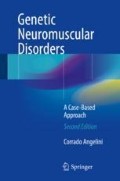Abstract
OPMD is a late-onset muscle disease associated with progressive ptosis of the eyelids, dysphagia [1–3], and unique tubulo-filamentous intranuclear inclusions [4]. The disease is caused by short (GCG)8–13 expansions in the polyadenylate-binding protein nuclear 1 gene (PABPN1, previously abbreviated PABP2) [5, 6], and mutant proteins have been shown to be the constituents of the nuclear inclusions [7], corresponding to aggregation of ubiquitin-tagged proteins, which cannot be degraded in the proteasomal machinery [8].
Access this chapter
Tax calculation will be finalised at checkout
Purchases are for personal use only
References
Victor M, Hayes R, Adams RD. Oculopharyngeal muscular dystrophy. A familial disease of late life characterized by dysphagia and progressive ptosis of the eyelids. N Engl J Med. 1962;267:1267–72.
Hayes R, London W, Seidman J, Embree L. Oculopharyngeal muscular dystrophy. N Engl J Med. 1963;268:163.
Murphy SF, Drachman DB. The oculopharyngeal syndrome. JAMA. 1968;203:1003–8.
Tome FMS, Fardeau M. Nuclear inclusions in oculopharyngeal dystrophy. Acta Neuropathol. 1980;49:85–7.
Brais B, Bouchard JP, Xie YG, et al. Short GCG expansions in the PABP2 gene cause oculopharyngeal muscular dystrophy. Nat Genet. 1998;18:164–7.
Blumen SC, Korczyn AD, Lavoie H, et al. Oculopharyngeal MD among Bukhara Jews is due to a founder (GCG)9 mutation in the PABP2 gene. Neurology. 2000;55:1267–70.
Calado A, Tome FMS, Brais B, Rouleau GA, Kuhn U, Wahle E, Carmo-Fonseca M. Nuclear inclusions in oculopharyngeal muscular dystrophy consist of poly(A) binding protein 2 aggregates which sequester poly(A) RNA. Hum Mol Genet. 2000;9:2321–8.
Abu-Baker A, Messaed C, Laganiere J, Gaspar C, Brais B, Rouleau GA. Involvement of the ubiquitin-proteasome pathway and molecular chaperones in oculopharyngeal muscular dystrophy. Hum Mol Genet. 2003;12:2609–23.
Author information
Authors and Affiliations
Rights and permissions
Copyright information
© 2018 Springer International Publishing Switzerland
About this chapter
Cite this chapter
Angelini, C. (2018). Oculopharyngeal Muscular Dystrophy. In: Genetic Neuromuscular Disorders. Springer, Cham. https://doi.org/10.1007/978-3-319-56454-8_34
Download citation
DOI: https://doi.org/10.1007/978-3-319-56454-8_34
Published:
Publisher Name: Springer, Cham
Print ISBN: 978-3-319-56453-1
Online ISBN: 978-3-319-56454-8
eBook Packages: MedicineMedicine (R0)

